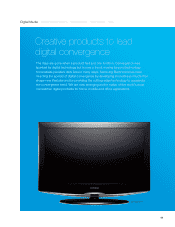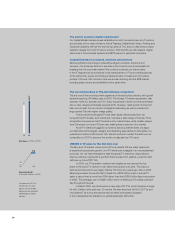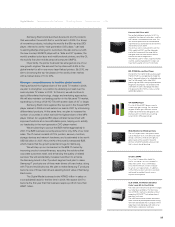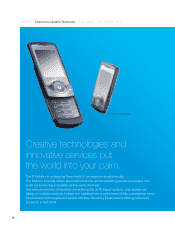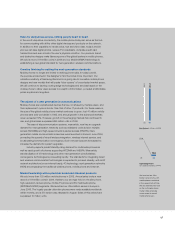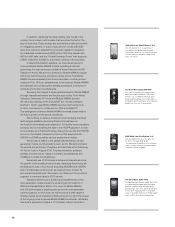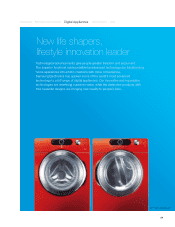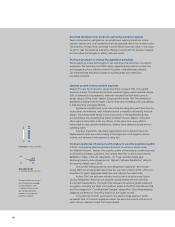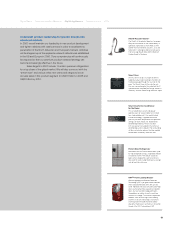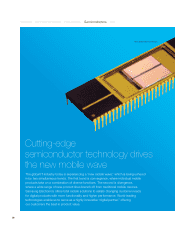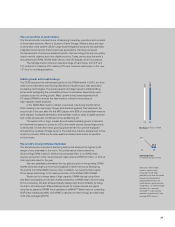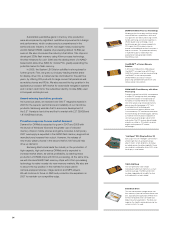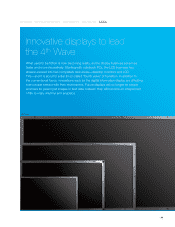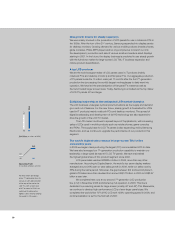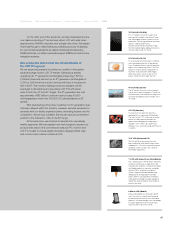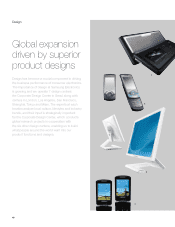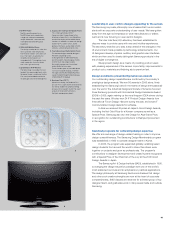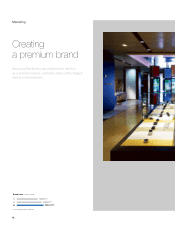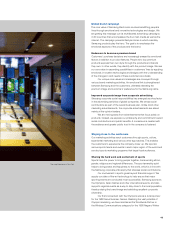Samsung 2006 Annual Report Download - page 43
Download and view the complete annual report
Please find page 43 of the 2006 Samsung annual report below. You can navigate through the pages in the report by either clicking on the pages listed below, or by using the keyword search tool below to find specific information within the annual report.
33
The cornerstone of performance
The Semiconductor business is one of Samsung’s mainstay operations and consists
of three major divisions: Memory, System LSI and Storage. Memory chips are used
to store data, while system LSI (for Large-Scale Integration) products are essentially
integrated circuit devices that process user applications. We have pioneered
the development of numerous advancements in chip technology that are now widely
used in mobile, desktop and other digital products. Today, we produce the world’s
most advanced DRAM, SRAM, flash memory and DDI (display driver IC) products.
The Storage Division offers an extensive range of hard drives, from 2.5˝ and
3.5˝ versions for notebook PCs, desktop PCs and consumer electronics, to the new
1.8˝ drive for mobile applications.
Stable growth amid rapid change
The DDR2 assumed the mainstream position in the DRAM market in 2006, at a time
when some chipmakers were having difficulties in transitioning to next-generation
processing technologies. The ensuing supply shortage helped to stabilize falling
prices while spotlighting the vulnerability inherent in excessive dependence upon
a single product for driving growth. Major growth drivers have expanded from
PC-based DRAMs to include the flash memory critical to the success of
high-capacity mobile products.
In the NAND flash memory market, inventories rose during the first half of
2006, leading to an oversupply. Supply and demand regained their balance in the
second half of the year after the first MP3 players with 8GB of onboard flash memory
were shipped. Increased demand for external flash memory cards in digital cameras
and mobile phones also contributed to the rebalancing act.
The system LSI, or logic, market also witnessed a steady growth in demand,
but downward pressure on prices for LCDs and mobile phones caused logic prices
to fall as well. On the other hand, growing global demand for camera-equipped
phones drove up sales of image sensors. The hard drive industry experienced further
erosion in prices in 2006 due to weak seasonal demand and severe competition
in the industry.
The world’s most profitable chipmaker
The Semiconductor business of Samsung Electronics achieved the highest profit
margin of any chipmaker in the world. This performance was bolstered by
the booming DRAM market in 2006 and a concerted effort to cut NAND flash
memory production costs. Semiconductor sales reached KRW19.8 trillion, or 32% of
total corporate sales for the year.
We have steadfastly maintained the top global position in the growing DRAM
market while also staying in front technologically in flash memory by developing
the world’s first 32Gb NAND memory chip. In addition, we were the first to apply
80nm design technology to the mass production of the 512Mb DDR2 DRAM.
We are set to increase sales of high-capacity DRAM devices using 90nm
and 80nm processing, and further market penetration of NAND flash memory using
60nm processing. We also achieved steady sales growth and profitability by being
the first to introduce such differentiated products for mobile devices and game
consoles as graphics DRAM, the proprietary OneNANDTM (flash memory combining
NOR’s fast reading capability with NAND’s capacity and fast writing), and distinctive
multi-chip packages (MCPs).
Samsung’s sales of high-
capacity memory chips
increased in 2006. High
profitability was also maintained
through the introduction of
unique DRAM products for
mobile devices, game consoles
and graphics, as well as through
the launch of its premium
OneNANDTM fusion memory
and other distinctive multi-chip
package (MCP) devices.
Operating Profit
(in hundreds of billions of KRW)
Net Sales (in trillions of KRW)
51.5
54.1
0605
06
20.7
20.3
05


